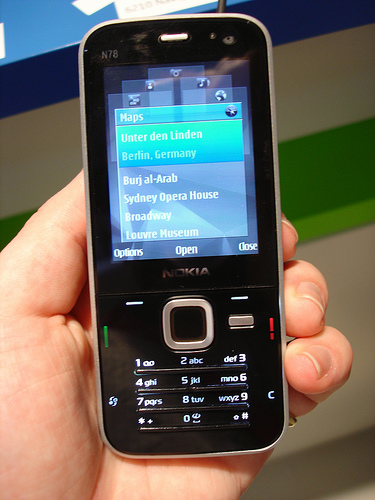Introduction
The Nokia N78, announced at Mobile World Congress 2008, is a candybar form factor Nseries phone with a 3.2 megapixel camera, integrated GPS with WiFi and HSDPA connectivity. It is Nokia’s new entry level Nseries product (a relative term when it comes to Nseries – the N78 comfortably qualifies as a mid to high-end product when seen in the context of Nokia’s complete device portfolio). In terms of hardware, the N78 is a step down from its Nseries sisters – less out of the box memory, smaller screen size, smaller camera resolution – but for the most part the actual functionality is still there, making the N78 a compelling proposition for those on a budget.
In terms of positioning, the N78 is a successor to the Nokia N73 (which was a successor to the N70). The Nokia N73 has been one of the best selling of Nokia’s Nseries, partly due to its price point, but also because it was, and is, a great all round handset. I’ll be drawing some comparisons throughout this preview as I suspect the N73 to N78 upgrade path will be a popular one.
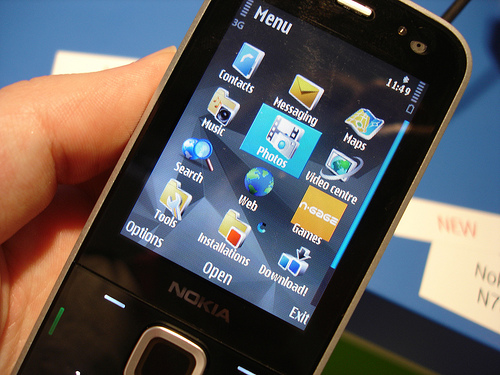
General Design and Hardware
At 113 x 49 x 15.1 mm, the N78 manages to pack an impressive amount of hardware into a relatively small volume. If size is a primary consideration when purchasing a phone, then the N78 may not be the phone for you, but for the majority of people the N78 slips into the pocketable category and compares favourably with most high end features phones (e.g. Sony Ericsson K850 at 102 x 48 x 17 mm).
The N78 is notably thinner and lighter (102g) than the N73 (110 x 49 x 19 mm, 116g), which is reflected in the overall volume (76.5 versus 89.1 cc) and consequently the N78 feels smaller in the hand.
The overall design of the N78 has similarities to the N81 and N96 – flat (black) plastics on the front, with silver-gray plastic sides and coloured ‘adzed-patterned’ plastics on the back. These designs have a fashion consciousness about them and move further way away from the utilitarian designs of some of the early Nseries, which were dominated by rounded beige and grey plastics. Fingerprints can be a bit of an issue with shiny black plastics, but the N78s at MWC, which were being handled by hundreds of people, weren’t anything like as bad as I expected – especially compared to the N81 or N76 at similar events. First impressions are somewhat deceptive with the N78 - looking at images of the N78, some may assume that usability is being subsumed by design, but this really isn’t the case. With the possible exception of the camera slide, a contentious area in itself, I found the N78 the equal or the superior of the N73 in every area.
The front of the device is divided between the 2.4 inch QVGA screen (bright and crisp) and the keys. The layout of candybar form factor phones are always a compromise between these two elements; the N78 manages this well and passes the crucial balanced-in-the-hand test even when using the bottom row of number keys.
The number key rows are divided by small ridges, but the keys themselves are flush with the surface. Despite appearances, the keys are very usable, with good tactile feedback; there’s just enough 'give' in the plastic surface and there’s a separate dome for each key, which gives a very distinct up and down sensation. Nokia knows how important an area this is and in user testing the N78 keypad has equalled the performance of the N73 in terms of speed of input and frequency of errors.
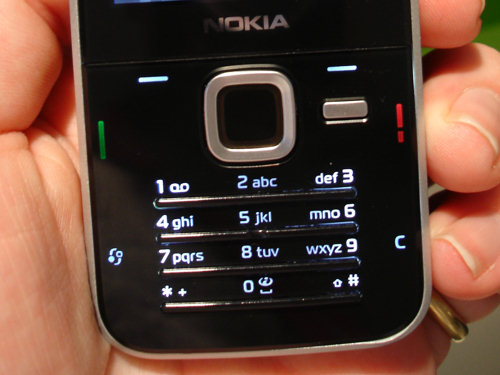
The Send and End keys are tucked away on the sides of the keypad, which makes sense as they become less important – these keys use to dominate keypad design, but in reality, although you may use them as frequently as before, this represents a much smaller fraction of overall device usage time. Moving them away also reduces the tendency for accidental End key presses dumping you out of S60 applications, as was common on the N73. Consequently, the softkeys have more room, although the right hand side is marginally cramped by the presence of the multimedia key. The central D-Pad is excellent – it also doubles as a touch sensitive navi-wheel (used for navigating long lists). Compared to the N73’s joystick, it is a pleasure to use, although, it is, perhaps, a little less suited to fast-paced action games.
The positioning of the S60 and cancel keys is a little out of the way. In particular, it seems that the S60 key could have been fitted in below the left-hand softkey, as a mirror match for the multimedia key. Perhaps its relegation reflects the fact that Nokia expects the N78’s target audience to make more use of the multimedia key and the improved access to multi-tasking in (S60 3rd Edition) Feature Pack 2?
The right hand side of the device has, from top to bottom, one of the two stereo speakers (its twin is diagonally opposite, on the bottom left hand side), the volume rocker key and the camera capture key. The left hand side has the microUSB port, microSD card slot, the power port and a stereo speaker. Both the microUSB port and the power port are more naturally at home on the bottom of the device, but clearly some compromises are necessary to keep the size down. The top of the device has the usual power button and a 3.5 mm audio jack. Those coming up from the N73 won’t be shedding any tears over the departure of the POP-port – it has taken a while, but Nokia is now standardising on microUSB and 3.5 mm audio ports.
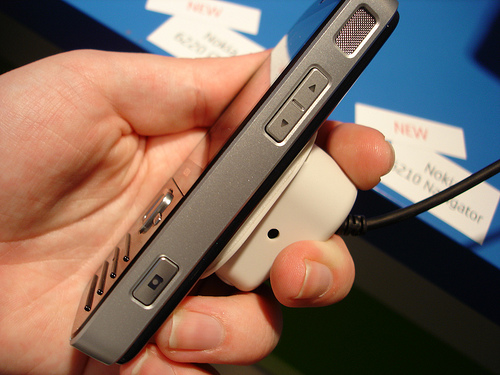
The 3.2 megapixel camera, with Carl Zeiss optics and accompanying LED flash on the back of the device, is surrounded by the ‘adzed-patterned’ coloured plastic mentioned earlier. Initially there will be three colour variants: pearl white, coca brown and lagoon blue.
Connectivity
The N78 is quad-band GSM and dual band WCDMA (900/2100MHz) with HSDPA. For the first time, Nokia announced a US variant (WCDMA 850/1900 Mhz) at launch and it is expected to be available a few weeks after the world version. The N78 also has WiFi (802.11b/g), Bluetooth and USB (high speed and mass storage profile supported) for local connectivity.
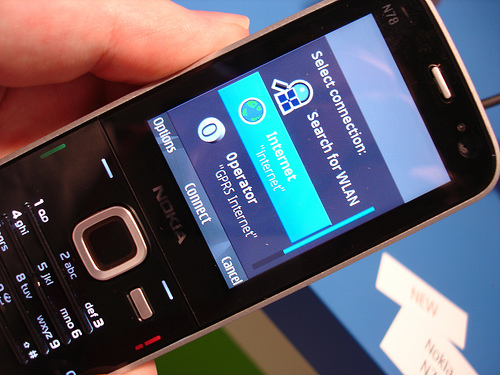
Both HSDPA and WiFi support are additions compared to the N73, so those upgrading will find a pleasant speed boost when browsing the Internet or using data connections. WiFi is used to support both VoIP calls, via the usual Nokia SIP client, and UPnP functionality.
As with the N96, the onboard UPnP software has been upgraded, compared to earlier Nseries devices - there are now extensive sync options, making it easier to copy media off the phone. Practically this means that the UPnP functionality offers a way to automatically sync home and mobile media content. It’s potentially an easy way to show off your captured media on your TV via a DLNA compatible device, such as the Playstation 3 or Xbox 360, and is especially relevant for the N78, given the absence of TV-Out. A copy of SimpleCenter (a Windows PC UPnP media server) will also be included in the box. However, I cannot help but think that Nokia should think about creating their own UPnP software – perhaps something that integrates with Nokia Photos?
Multimedia
The N78 has the same multimedia menu as its recent Nseries sisters, the carousel and panel-based menu is unrecognisable from the multimedia menu that premiered in N73. It allows quick access to, and for many users will be the primary interface with, the device’s multimedia functionality.
Compared to the N73, the N78 offers a much more polished multimedia experience. The music player, video handling and imaging have all been greatly improved. What’s more, because most functions are software based, the N78, in multimedia terms, is pretty much on a par with higher end devices such as the N82 and N96.
The N78 is an N-Gage compatible handset. We’ll revisit this area once the phone is available, but for now we’ll look at some of the multimedia functionality in more detail.
Camera
At 3.2 megapixels (auto-focus, with Carl Zeiss optics), the N78’s camera does not match the 5 megapixels found on the N95 and N82, but will still produce very good results. The N78’s LED flash is going to help somewhat in low light conditions but, as is typical with such cameraphones, you’ll get the best results when using the camera in well lit conditions.
As we noted in our N82 review, for mobile phones the megapixel figure is not necessarily a good measure of camera quality. The N73, with an identical specification was able to produce good results. However, since then the camera hardware has evolved and (more importantly) Nokia has put a lot of work into its image processing algorithms and camera drivers. This should translate into better quality images and faster shot times on the N78. Detailed examination of the N78’s camera performance will have to wait for production units, but you can certainly expect decent results. The N78 lacks the camera slide of the N73, which means the camera is activated via the capture button rather than a mechanical slide. Mechanical shutters and covers may provide a more intuitive experience, but they do add to the bulk and cost of a device.The N78 should also perform well in the video department. It can capture VGA (640 x 480, up from 352 x 288 on the N73) video at 15 frames per second and also features video stabilization.
But the big improvements in the N78’s imaging story come not from the hardware, but from the accompanying software. Nokia says that feedback from N73 users indicated that they were happy with the performance of the camera, but were unable to do much with the numerous photos that were stored on the phone. Thus a key focus during the development of the N78 was ensuring that users would be able to make the most of their captured images.
Share online, which allows the upload of media to online services such as Flickr, Share on Ovi, and Print online, which allows you order prints directly from your phone which are subsequently delivered by post, are all available out of the box and serve as ways of getting photos off the phone. Share online is particularly important here, as it integrates with both the Camera and Photos application, allowing for one click uploads to the web.
Photos is a new image and video viewing application, replacing Gallery in this role. Photos and videos can be viewed by a number of pseudo-categories: Captured (recently captured images), Months (by time), Albums (user defined categories), Tags (user defined taxonomy), Downloads and All. Once you drop into one of these top categories and choose a month, album or tag photos are viewed using the familiar photo carousel.
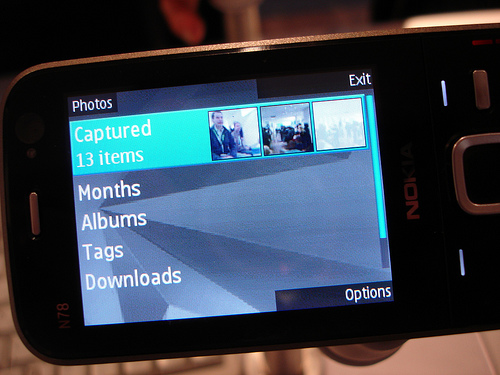
The N73’s Gallery application was notorious for being sluggish, especially when viewing carousels of photos (thumbnail drawing rarely kept up with on screen movements). The good news is that the carousel has been re-designed from the ground up for the new Photos application and it also benefits from the faster processor of the N78. The end result is much better performance, with little or no lag time when moving around the carousel or viewing photos. A nice touch is the inclusion of an on-screen indication of where you are on a carousel, making it easy to navigate around large groupings of photos. When viewing an individual photo, you are able to add album and tag information, as well as the usual send, print, edit, slideshow and use image commands.
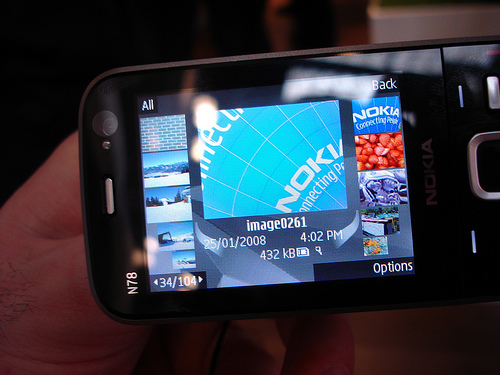
Paired with the Photos application on the phone is the new Photos application for the PC; this delivers much improved PC-phone photo synchronization. When syncing to the PC application, the album, tag and other meta data is preserved, which means photos arrive on your PC already organised (assuming you’ve been efficient on the phone) and this joined-up experience is a big improvement over what went before (PC Suite’s Image Store module). The PC application supports the same online services as the phone offering an impressive three-way integration between mobile, PC and Internet. Clearly this is Nokia’s Ovi strategy in action, though of course most consumers will not care about the strategy, but rather about the improved experience.
The camera software itself is updated to the latest version of the Nseries camera application (adding more settings and greater control over camera particulars), but most impressive is the new support for automatic location tagging (also known as geotagging). This uses the N78’s integrated GPS and embeds a photos location into the EXIF headers of the image file. When browsing such images in the Photos application, there is a 'show on map' option which opens the Maps application and zooms to where your photo was taken. When you then upload location tagged photos to a service such as Flickr you can choose to view them on a map. A nice touch is that when the camera application is in use the number keys fade out as they are not used - this makes it look like the buttons have disappeared - making for a more camera like experience.
It’ll be interesting to see how much people take to location tagging. It easy to dismiss it as a bit gimmicky, however if it is happening in the background without any user intervention then it becomes just another bit of data embedded in the photo. Viewing captured images on a map is very intuitive and certainly solves the ‘where did I take this photo’ question when you’re looking back at photos taken six months earlier. Incidentally, by default, location tagging is switched off due to privacy concerns, which is a timely reminder of the sensitivities around location issues.
GPS and Nokia Maps
Location tagging may grab headlines, but the primary use of a GPS remains as a navigation aid. The included Nokia Maps 2.0 software gives the maps and basic routing away for free, but navigation (either driving or walking) is a premium add-on. The on-demand service and pricing that Nokia have chosen to adopt should go down well with the target audience of the N78. Nokia Maps 2.0 is still in beta, but you can look at All About Symbian’s first review of its capabilities here. Features include separate navigation modes for drivers and pedestrians, a large point of information database, 2D, 3D, satellite and hybrid maps views, travel guides and traffic information (the last two are premium add-ons). Version 2.0 features a redesigned user interface with a number of usability improvements and a more PND like menu in navigation mode. Nokia Maps is still evolving and updates are likely to be made available via download during the lifetime of the N78.
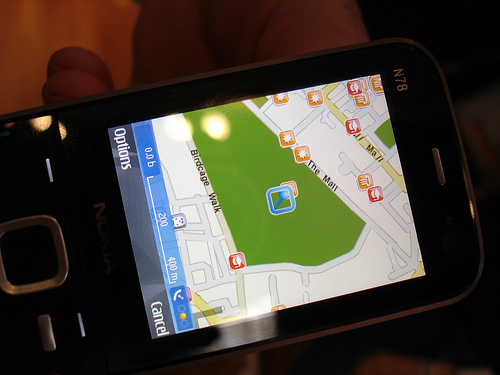
With A-GPS functionality and the lessons learnt in aerial placement from the N95, it's safe to say that the performance of the N78’s GPS should be good. In recent handsets Nokia have got GPS lock-on down to about 40 seconds from a cold start and just a handful of seconds from a warm start – impressive stuff and a far cry from the multi-minute wait of the N95, Nokia’s first GPS equipped phone, with original firmware.
In some markets, the maps for your area will also be preloaded on the included microSD card, which should help keep down data transfer costs and encourage novice users. The GPS and Nokia Maps functionality is one the major additions in the N78, when compared to the N73, and while Nokia Maps can be downloaded on to older phones (including the N73), the importance of having things ready to go out of the box should not be underestimated.
Video, Music and Audio
Video is played back via the RealPlayer application, which supports various formats including the usual 3GPP formats (including H.263), MPEG-4 and H.264.
The Video Centre application facilitates the downloading of video from a variety of sources. Some sources are preloaded on the device and more are available via an 'Add videos' link. Video centre also allows you to add your own sources (as RSS feeds); there are a increasing number of these video podcasts becoming available and they serve as an easy way of getting free video content onto the device.
The N78 has the standard Nseries Music player application, with the music library, album art, visualisation, 6-way equaliser, active idle plug-in and integrated podcasting support. With no music playback controls on the device, you have to access the Music player application itself and use the D-pad to control music playback. Fortunately, the in box headset does include media remote controls, which provide a workable, if less widely applicable, alternative. Format-wise, the N78 supports the usual suspects, including MP3, AAC, AAC+ and WMA; it also includes DRM support for both Windows Media and OMA 2.0.
As we’ve mentioned in previous Nseries reviews, Podcasting, with its on-device subscription and downloading, is a particular highlight. Nokia have continued to embrace web-based media delivery with the inclusion of the Internet Radio application in the N78. This plays audio streams of radio stations delivered over the Internet and uses shoutcast (MP3 and AAC) streams. A large number of radio stations are predefined in the application, but you can always add your own. Support for RealAudio streams (as used by the BBC and some others) is on the product roadmap for Internet Radio, but is unlikely to be in the version that ships with the N78. Internet Radio does require a flat rate data plan and uses more battery than a FM radio, but on the other hand it can access many more stations, does not require you to plug in a headset for use as an aerial and can provide superior quality audio.
Nokia deserves a lot of credit for developing this functionality and promoting it to the mass market. For technophiles it might not seem to be that big of a deal, but for many the N78 will be the first time they’ve been exposed to these media delivery mechanisms.
For old timers there is a stereo FM Radio and this now includes RDS (displays data such as station name and current song) support. The Radio application has a content directory which lets you automatically download presets for your local area, though coverage is very variable.
The stereo speakers, 3.5 mm audio jack and Bluetooth (via A2DP and AVRCP) can all be used to get audio out of the device, but the real highlight is the inclusion of an FM transmitter. This allows you to send to audio output via an FM signal to any FM receiver. It’s a very low power signal with a range of about a metre so the obvious use case is with a car radio or stereo. The FM transmitter can be activated via a simple menu option in Music player and the frequency can be changed (88.1 -109.9) to avoid clashing with broadcast radio channels. The FM transmitter also supports RDS; currently this only sends ‘Nokia’ as the channel name, but perhaps this could be upgraded to include track information in later firmware releases. As mentioned, the power output is very low, so the FM transmitter has a minimal impact on battery life. The inclusion of an FM transmitter in the N78 is a nice touch and serves to remind us that older technology, because of its installed user base, still has much to offer.
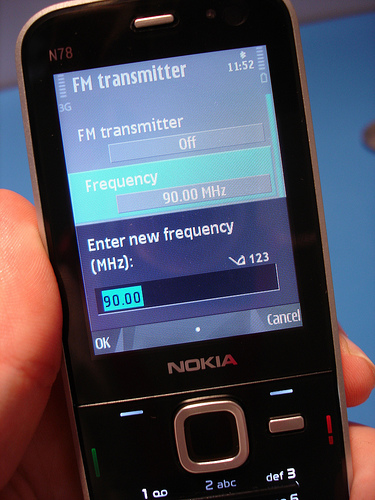
The video, music and audio experience of the N78 is considerably improved over the N73. There’s now better integration and less annoyances (e.g. no more manually updating the music library), which reflect a general maturity in the multimedia capabilities of Nseries devices. Nokia’s Music store also has a role to play – it adds an extra dimension to the capabilities of the device, since it allows you to explore and consume new media directly from the device.
Software
The N78 runs S60 3rd Edition Feature Pack 2 on Symbian OS 9.3. Outside of the multimedia applications we mentioned above, the usual standard suite of software is present, including the PIM trio of Contacts, Calendar and Messaging. Web, Search and various office applications are all present. Feature Pack 2 brings a number of minor updates to these applications, but it is usability changes to the user interface that get most of the immediate attention.
The most obvious user interface change is the addition of a central softkey. This, for the most part, explicitly labels functionality that was already there, but should make things clearer to new users. Multi-tasking is made more obvious thanks to a redesigned task-switcher and the addition of an 'Open applications' item to the top of all Options menus.
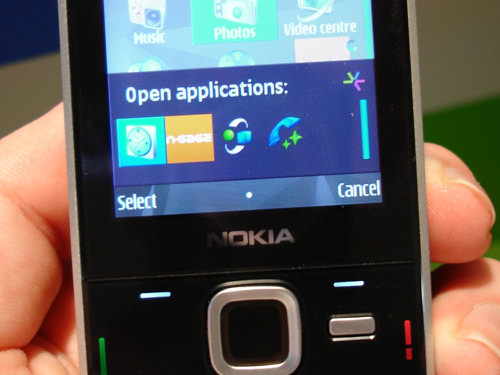
Other changes that should be popular among N78 users include support for progressive downloads (start playing media during download), faster loading Java applications, full-screen picture caller ID for incoming calls, the inclusion of Flash Lite 3 (watch YouTube and other Flash videos in the browser), and inclusion of the WRT runtime (widgets).
Feature Pack 2 is a major software upgrade for S60 and brings in numerous changes, in addition to those mentioned above; we’ll be covering it in more detail a future preview article.
Miscellaneous and Technical
The N78 has a 1200 mAh (BL-6F) battery, which should provide good running time. It is notably better than some other recent Nseries (e.g. the N96’s 950 mAh battery) and should last 48 hours with fairly heavy usage and longer with light usage. A good example of this is the claimed 24 hour music playback time, longer than any previous Nseries device.
The standard N78 will ship with a 2GB memory card included in the sales package, to augment the 70 MB of onboard memory. There is 96 MB of RAM on board (around 48 MB after booting) which should be more than sufficient, especially as 'demand paging' is now a standard part of Feature Pack 2.
The N78 uses a single chip processor (from Freescale) running at 369 MHz, as successfully used in the Nokia 6120 and N81. In use, the device runs quickly and, as with other recent S60 devices, slow downs appear to be a thing of the past.
Conclusion
N73 users looking to upgrade will be well satisfied with the N78. It combines impressive capabilities in a popular form factor at a reasonable price point. Power users may see the N78 as the little sister of the Nseries family, but its significance should not be underestimated.
I’ve little doubt that the N78 will repeat the success of the N73 in sales terms, but, more than that, I think it will help spread Nokia’s new Internet led strategy (Ovi) to a much wider audience. In that sense, it has the potential to be even more significant than the N73.
In the last few years, the overall multimedia consistency of Nseries phones has improved considerably – the N78 benefits greatly from this. The N73 was a decent music player and camera, but rough edges (such as no standard audio jack and poor PC and web integration) let it down, especially for the average user. This poor user experience meant that the abilities of the N73 were not fully realised by the majority of its users. The N78 goes a long way to smoothing these rough edges: the multimedia software is better integrated and more complete. Nokia have appreciated that it is not enough to just provide the device; they also need to provide enabling software services too. The N78, with navigation, also adds new functionality, further burnishing its convergence credentials and providing users with another reason to buy into convergence.
Stepping back to a broader perspective, what is interesting is that Nokia have primarily sought to improve the N78 not by evolving the hardware, but by innovating in the software area. The most obvious example of this is in the imaging experience with its improved camera software, support for geotagging, better PC sync and better online sharing. This software (and services)-led improvement is something I expect to see a lot more of in the future. Thus I think the N78 can be seen as representative of a change in the way Nseries will evolve in the future.
The N78 will be available from July 2008 for 350 Euros (before tax and subsidies).

